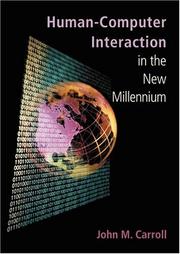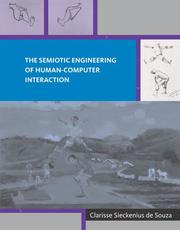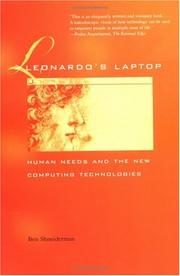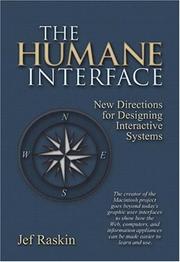| Listing 1 - 9 of 9 |
Sort by
|

ISBN: 0201704471 9780201704471 Year: 2002 Publisher: New York, N.Y. Boston, MA ACM Press Addison-Wesley
Abstract | Keywords | Export | Availability | Bookmark
 Loading...
Loading...Choose an application
- Reference Manager
- EndNote
- RefWorks (Direct export to RefWorks)
The ways in which humans interact with computers will change dramatically in the coming years. In this book, the field's leading experts preview that future, focusing on critical technical challenges and opportunities that will define Human-Computer Interaction research for years and decades to come. Editor John M. Carroll, a leader of the HCI community, has assembled essays that anticipate tomorrow's state-of-the-art -- and its implications for users, professionals, and society. These essays cover every area of research, including models, theories, and frameworks; usability engineering; user interface software and tools; HCI for collaborative applications; HCI for multimedia and hypermedia; integrating real and virtual worlds; and HCI's impact on society. Discover advanced cognitive models for evaluating user interfaces; preview the future of user interface software tools; and learn how user interfaces can support innovation. Preview tomorrow's intelligent interfaces, recommender systems, and tangible user interfaces; as well as interface solutions for digital libraries and ubiquitous computing systems. Carroll provides cogent introductions to each essay, as well as a detailed preface offering an overview of the entire field.
Human-computer interaction --- User-centered system design --- Human-computer interaction. --- #SBIB:309H1720 --- #SBIB:309H03 --- Attitude to Computers --- Attitude to Computer --- Computer, Attitude to --- Computers, Attitude to --- to Computer, Attitude --- to Computers, Attitude --- Computers --- Computer-human interaction --- Human factors in computing systems --- Interaction, Human-computer --- Human engineering --- User interfaces (Computer systems) --- Informatiekunde, informatie management --- Systeemtheorie: cybernetica systeemleer, mathematische informatietheorie

ISBN: 0262042207 9780262042208 Year: 2005 Publisher: Cambridge, Mass. MIT Press
Abstract | Keywords | Export | Availability | Bookmark
 Loading...
Loading...Choose an application
- Reference Manager
- EndNote
- RefWorks (Direct export to RefWorks)
"In The Semiotic Engineering of Human Computer Interaction Clarisse Sieckenius de Souza proposes an account of HCI that draws on concepts from semiotics and computer science to investigate the relationship between user and designer. Semiotics is the study of signs, and the essence of semiotic engineering is the communication between designers and users at interaction time; designers must somehow be present in the interface to tell users how to use the signs that make up a system or program. This approach, which builds on - but goes further than - the currently dominant user-centered approach, allows designers to communicate their overall vision and therefore helps users understand designs - rather than simply which icon to click."--Jacket.
Human-computer interaction --- Semiotics --- Attitude to Computers --- #SBIB:309H1720 --- Attitude to Computer --- Computer, Attitude to --- Computers, Attitude to --- to Computer, Attitude --- to Computers, Attitude --- Computers --- Semeiotics --- Semiology (Linguistics) --- Semantics --- Signs and symbols --- Structuralism (Literary analysis) --- Computer-human interaction --- Human factors in computing systems --- Interaction, Human-computer --- Human engineering --- User-centered system design --- User interfaces (Computer systems) --- Informatiekunde, informatie management

ISBN: 1282096281 026225607X 9786612096280 1435619811 9780262256070 9780262050883 0262292645 9781435619814 0262050889 Year: 2008 Publisher: Cambridge, Mass. MIT Press
Abstract | Keywords | Export | Availability | Bookmark
 Loading...
Loading...Choose an application
- Reference Manager
- EndNote
- RefWorks (Direct export to RefWorks)
Over almost three decades, the field of human-computer interaction (HCI) has produced a rich and varied literature. Although the focus of attention today is naturally on new work, older contributions that played a role in shaping the trajectory and character of the field have much to tell us. The contributors to HCI Remixed were asked to reflect on a single work at least ten years old that influenced their approach to HCI. The result is this collection of fifty-one short, engaging, and idiosyncratic essays, reflections on a range of works in a variety of forms that chart the emergence of a new field. An article, a demo, a book: any of these can solve a problem, demonstrate the usefulness of a new method, or prompt a shift in perspective. HCI Remixed offers us glimpses of how this comes about. The contributors consider such HCI classics as Sutherland's Sketchpad, Englebart's demo of NLS, and Fitts on Fitts' Law--and such forgotten gems as Pulfer's NRC Music Machine, and Galloway and Rabinowitz's Hole in Space. Others reflect on works somewhere in between classic and forgotten--Kidd's "The Marks Are on the Knowledge Worker," King Beach's "Becoming a Bartender," and others. Some contributors turn to works in neighboring disciplines--Henry Dreyfuss's book on industrial design, for example--and some range farther afield, to Lovelock's Gaia hypothesis and Jane Jacobs's The Death and Life of Great American Cities. Taken together, the essays offer an accessible, lively, and engaging introduction to HCI research that reflects the diversity of the field's beginnings. Thomas Erickson is Research Staff Member at the IBM T.J. Watson Research Center. David W. McDonald is Assistant Professor at the Information School at the University of Washington, Seattle.
Human-computer interaction. --- Computer-human interaction --- Human factors in computing systems --- Interaction, Human-computer --- Human engineering --- User-centered system design --- User interfaces (Computer systems) --- COMPUTER SCIENCE/Human Computer Interaction --- DIGITAL HUMANITIES & NEW MEDIA/General --- SOCIAL SCIENCES/Media Studies --- Human-computer interaction --- Attitude to Computers --- #SBIB:309H1720 --- #SBIB:309H1730 --- Attitude to Computer --- Computer, Attitude to --- Computers, Attitude to --- to Computer, Attitude --- to Computers, Attitude --- Computers --- Informatiekunde, informatie management --- Artificiële Intelligentie, knowledge engineering,

ISBN: 0262256983 0585444994 9780262256988 9780585444994 9780262692991 026225042X 9780262194761 0262194767 0262692996 Year: 2003 Publisher: Cambridge, Mass. MIT Press
Abstract | Keywords | Export | Availability | Bookmark
 Loading...
Loading...Choose an application
- Reference Manager
- EndNote
- RefWorks (Direct export to RefWorks)
This text aims to raise computer users' expectations of what they should get from technology. It shifts the focus from what computers can do to what users can do.
Electronic data processing. --- Human-computer interaction. --- Technological forecasting. --- Technology --- Computer-human interaction --- Human factors in computing systems --- Interaction, Human-computer --- ADP (Data processing) --- Automatic data processing --- Data processing --- EDP (Data processing) --- IDP (Data processing) --- Integrated data processing --- Forecasting --- Technology transfer --- Human engineering --- User-centered system design --- User interfaces (Computer systems) --- Computers --- Office practice --- Automation --- SCIENCE, TECHNOLOGY & SOCIETY/General --- COMPUTER SCIENCE/Human Computer Interaction --- Computer. Automation --- Electronic data processing --- Human-computer interaction --- Technological forecasting --- Information technology --- Attitude to Computers --- #SBIB:309H1720 --- Attitude to Computer --- Computer, Attitude to --- Computers, Attitude to --- to Computer, Attitude --- to Computers, Attitude --- IT (Information technology) --- Telematics --- Information superhighway --- Knowledge management --- Informatiekunde, informatie management

ISBN: 0262072483 9780262072489 Year: 2004 Publisher: Cambridge, Mass. MIT Press
Abstract | Keywords | Export | Availability | Bookmark
 Loading...
Loading...Choose an application
- Reference Manager
- EndNote
- RefWorks (Direct export to RefWorks)
"Gay and Hembrooke examine the ongoing interaction of computer systems use, design practice, and design evaluation, using the concepts of activity theory and related methods as a theoretical framework."--Jacket.
Human-computer interaction. --- System design. --- Human-machine systems --- Interaction homme-machine (Informatique) --- Systèmes, Conception de --- Systèmes homme-machine --- Design --- Conception --- Human-computer interaction --- System design --- Attitude to Computers --- #SBIB:309H1720 --- Attitude to Computer --- Computer, Attitude to --- Computers, Attitude to --- to Computer, Attitude --- to Computers, Attitude --- Computers --- Human operators (Systems engineering) --- Human subsystems (Systems engineering) --- Man-machine control systems --- Man-machine systems --- Operator-machine systems --- Engineering systems --- Human engineering --- Design, System --- Systems design --- Electronic data processing --- System analysis --- Computer-human interaction --- Human factors in computing systems --- Interaction, Human-computer --- User-centered system design --- User interfaces (Computer systems) --- Informatiekunde, informatie management

ISBN: 0201379376 9780201379372 Year: 2000 Publisher: Reading, Mass. Addison-Wesley
Abstract | Keywords | Export | Availability | Bookmark
 Loading...
Loading...Choose an application
- Reference Manager
- EndNote
- RefWorks (Direct export to RefWorks)
This unique guide to interactive system design reflects the experience and vision of Jef Raskin, the creator of the Apple Macintosh. Other books may show how to use today's widgets and interface ideas effectively. Raskin, however, demonstrates that many current interface paradigms are dead ends, and that to make computers significantly easier to use requires new approaches. He explains how to effect desperately needed changes, offering a wealth of innovative and specific interface ideas for software designers, developers, and product managers.
Computer architecture. Operating systems --- Human-computer interaction --- User interfaces (Computer systems) --- Interaction homme-machine (Informatique) --- Interfaces (Informatique) --- Computer interfaces --- Software Design --- Attitude to Computers --- User-Computer Interface --- #SBIB:309H1720 --- Attitude to Computer --- Computer, Attitude to --- Computers, Attitude to --- to Computer, Attitude --- to Computers, Attitude --- Computers --- Flow Charts (Computer) --- Flowcharts --- Flowcharts (Computer) --- Chart, Flow (Computer) --- Charts, Flow (Computer) --- Design, Software --- Designs, Software --- Flow Chart (Computer) --- Flowchart --- Flowchart (Computer) --- Software Designs --- Interfaces, Computer --- Computer input-output equipment --- Interface circuits --- Interfaces, User (Computer systems) --- Human-machine systems --- Computer-human interaction --- Human factors in computing systems --- Interaction, Human-computer --- Human engineering --- User-centered system design --- User Computer Interface --- Interface, User Computer --- Virtual Systems --- Interface, User-Computer --- Interfaces, User Computer --- Interfaces, User-Computer --- System, Virtual --- Systems, Virtual --- User Computer Interfaces --- User-Computer Interfaces --- Virtual System --- Speech Recognition Software --- Brain-Computer Interfaces --- Informatiekunde, informatie management

ISBN: 9780262112987 9780262513319 0262112981 9780262256476 0262513315 Year: 2006 Publisher: Cambridge, Mass. MIT Press
Abstract | Keywords | Export | Availability | Bookmark
 Loading...
Loading...Choose an application
- Reference Manager
- EndNote
- RefWorks (Direct export to RefWorks)
Activity theory holds that the human mind is the product of our interaction with people & artifacts in everyday activity. This book makes the case for activity theory as a basis for understanding our relationship with technology. It describes activity theory's principles, history, & relationship to other theoretical approaches.
Human-computer interaction --- Design --- User interfaces (Computer systems) --- Action theory --- Human factors --- Technology --- Sociology --- Ethnology --- Attitude to Computers --- Anthropology, Cultural --- User-Computer Interface --- Primitive Societies --- Primitive Society --- Societies, Primitive --- Society, Primitive --- User Computer Interface --- Interface, User Computer --- Virtual Systems --- Interface, User-Computer --- Interfaces, User Computer --- Interfaces, User-Computer --- System, Virtual --- Systems, Virtual --- User Computer Interfaces --- User-Computer Interfaces --- Virtual System --- Speech Recognition Software --- Brain-Computer Interfaces --- Cultural Anthropology --- Material Culture --- Ethnography --- Culture, Material --- Ethnographies --- Material Cultures --- Qualitative Research --- General Social Development and Population --- Attitude to Computer --- Computer, Attitude to --- Computers, Attitude to --- to Computer, Attitude --- to Computers, Attitude --- Computers --- Arts, Industrial --- Industrial Arts --- Cloud Computing --- Cultural anthropology --- Races of man --- Social anthropology --- Anthropology --- Human beings --- Social theory --- Social sciences --- Applied science --- Arts, Useful --- Science, Applied --- Useful arts --- Science --- Industrial arts --- Material culture --- Goal-directed action --- Goal-directed behavior --- Theory, Action --- Psychology --- Interfaces, User (Computer systems) --- Human-machine systems --- Human factors in design --- Human engineering --- Computer-human interaction --- Human factors in computing systems --- Interaction, Human-computer --- User-centered system design --- Philosophy --- Design - Human factors

ISBN: 0471880159 Year: 1987 Publisher: New York (N.Y.): Wiley
Abstract | Keywords | Export | Availability | Bookmark
 Loading...
Loading...Choose an application
- Reference Manager
- EndNote
- RefWorks (Direct export to RefWorks)
Human engineering --- Attitude to Computers --- Environment Design. --- Ergonomics. --- Systems Analysis --- Productietechnologie (procescontrole : procesopvolging) 658.513 --- 331.45 --- 612.76 --- 612.8 --- 65.015.11 --- Agent-Based Modeling --- Analysis, Systems --- Complexity Analysis --- System Dynamics Analysis --- Systems Approach --- Systems Medicine --- Systems Oriented Approach --- Systems Thinking --- Agent Based Modeling --- Agent-Based Modelings --- Analyses, Complexity --- Analyses, System Dynamics --- Analyses, Systems --- Analysis, Complexity --- Analysis, System Dynamics --- Approach, Systems --- Approach, Systems Oriented --- Approachs, Systems --- Approachs, Systems Oriented --- Complexity Analyses --- Dynamics Analyses, System --- Dynamics Analysis, System --- Medicine, Systems --- Medicines, Systems --- Modeling, Agent-Based --- Modelings, Agent-Based --- System Dynamics Analyses --- Systems Analyses --- Systems Approachs --- Systems Medicines --- Systems Oriented Approachs --- Systems Thinkings --- Thinking, Systems --- Thinkings, Systems --- Research --- Systems Theory --- Cognitive Ergonomics --- Ergonomic Assessment --- Human Factors Engineering --- Human Factors and Ergonomics --- Organizational Ergonomics --- Physical Ergonomics --- Psychology, Engineering --- Visual Ergonomics --- Engineering Psychology --- Human Engineering --- Cognitive Ergonomic --- Ergonomic --- Ergonomic Assessments --- Ergonomic, Cognitive --- Ergonomic, Organizational --- Ergonomic, Physical --- Ergonomic, Visual --- Ergonomics, Cognitive --- Ergonomics, Organizational --- Ergonomics, Physical --- Ergonomics, Visual --- Human Factors Engineerings --- Organizational Ergonomic --- Physical Ergonomic --- Visual Ergonomic --- Psychology, Industrial --- Design, Environment --- Healthy Places --- Designs, Environment --- Environment Designs --- Healthy Place --- Attitude to Computer --- Computer, Attitude to --- Computers, Attitude to --- to Computer, Attitude --- to Computers, Attitude --- Computers --- Handbooks, manuals, etc --- Arbeidsbescherming. Arbeidsbeveiligiging. Bescherming op het werk. Veiligheid op het werk --- Locomotie. Beweging. Lichaamsmechanica. Biomedische ingenieurstechnieken --- Zenuwstelsel. Zintuigen. Motorische neurowetenschappen --- Ontwerp en indeling van fabriek en uitrusting. Ontwerp en aanpassing van gereedschappen en machines voor de mens. Ergonomie --- Sociology of work --- Environment Design --- Ergonomics

ISBN: 0471116904 Year: 1997 Publisher: New York (N.Y.): Wiley
Abstract | Keywords | Export | Availability | Bookmark
 Loading...
Loading...Choose an application
- Reference Manager
- EndNote
- RefWorks (Direct export to RefWorks)
arbeidsvraagstukken --- ergonomie --- bedrijfsorganisatie --- Sociology of work --- Organization theory --- Attitude to Computers. --- Environment Design. --- Systems Analysis. --- Human Engineering. --- 65.015.11 --- 65.015.12 --- 331.101.1 --- Human engineering --- -Ergonomics --- Human factors in engineering design --- Bioengineering --- Environmental engineering --- Industrial engineering --- Human comfort --- Human-robot interaction --- Human Factors Engineering --- Human Factors and Ergonomics --- Psychology, Engineering --- Engineering Psychology --- Ergonomics --- Engineering, Human --- Engineering, Human Factors --- Engineerings, Human Factors --- Factors Engineering, Human --- Factors Engineerings, Human --- Human Factors Engineerings --- Psychology, Industrial --- Agent-Based Modeling --- Analysis, Systems --- Complexity Analysis --- System Dynamics Analysis --- Systems Approach --- Systems Medicine --- Systems Oriented Approach --- Systems Thinking --- Agent Based Modeling --- Agent-Based Modelings --- Analyses, Complexity --- Analyses, System Dynamics --- Analyses, Systems --- Analysis, Complexity --- Analysis, System Dynamics --- Approach, Systems --- Approach, Systems Oriented --- Approachs, Systems --- Approachs, Systems Oriented --- Complexity Analyses --- Dynamics Analyses, System --- Dynamics Analysis, System --- Medicine, Systems --- Medicines, Systems --- Modeling, Agent-Based --- Modelings, Agent-Based --- System Dynamics Analyses --- Systems Analyses --- Systems Approachs --- Systems Medicines --- Systems Oriented Approachs --- Systems Thinkings --- Thinking, Systems --- Thinkings, Systems --- Research --- Systems Theory --- Design, Environment --- Designs, Environment --- Environment Designs --- Attitude to Computer --- Computer, Attitude to --- Computers, Attitude to --- to Computer, Attitude --- to Computers, Attitude --- Computers --- Ontwerp en indeling van fabriek en uitrusting. Ontwerp en aanpassing van gereedschappen en machines voor de mens. Ergonomie --- Vormgeving van de werkplaats --- Ergonomie. Aanpassing van de mens aan de machine --- Handbooks, manuals, etc --- -Ontwerp en indeling van fabriek en uitrusting. Ontwerp en aanpassing van gereedschappen en machines voor de mens. Ergonomie --- Attitude to Computers --- Environment Design --- Human Engineering --- Systems Analysis --- Cognitive Ergonomics --- Ergonomic Assessment --- Organizational Ergonomics --- Physical Ergonomics --- Visual Ergonomics --- Cognitive Ergonomic --- Ergonomic --- Ergonomic Assessments --- Ergonomic, Cognitive --- Ergonomic, Organizational --- Ergonomic, Physical --- Ergonomic, Visual --- Ergonomics, Cognitive --- Ergonomics, Organizational --- Ergonomics, Physical --- Ergonomics, Visual --- Organizational Ergonomic --- Physical Ergonomic --- Visual Ergonomic --- Built Environment --- Healthy Places --- Built Environments --- Healthy Place --- Ergonomics. --- Handbooks, manuals, etc. --- Human engineering - Handbooks, manuals, etc.
| Listing 1 - 9 of 9 |
Sort by
|

 Search
Search Feedback
Feedback About UniCat
About UniCat  Help
Help News
News